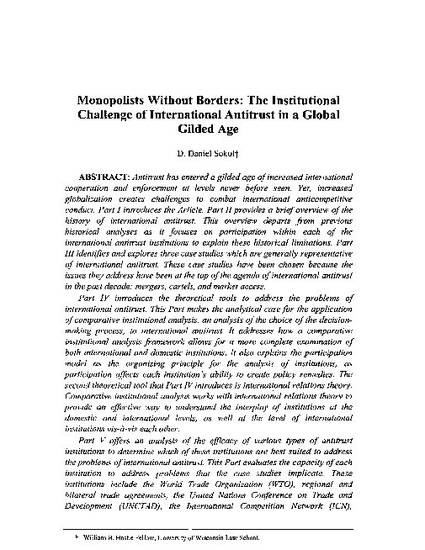
Antitrust has entered a gilded age of increased international cooperation and enforcement at levels never before seen. Yet, increased globalization creates challenges to combat international anticompetitive conduct. Part I introduces the Article. Part II provides a brief overview of the history of international antitrust. This overview departs from previous historical analyses as it focuses on participation within each of the international antitrust institutions to explain these historical limitations. Part III identifies and explores three case studies which are generally representative of international antitrust. These case studies have been chosen because the issues they address have been at the top of the agenda of international antitrust in the past decade: mergers, cartels, and market access.
Part IV introduces the theoretical tools to address the problems of international antitrust. This Part makes the analytical case for the application of comparative institutional analysis, an analysis of the choice of the decision making process, to international antitrust. It addresses how a comparative institutional analysis framework allows for a more complete examination of both international and domestic institutions. It also explains the participation model as the organizing principle for the analysis of institutions, as participation affects each institution's ability to create policy remedies. The second theoretical tool that Part IV introduces is international relations theory. Comparative institutional analysis works with international relations theory to provide an effective way to understand the interplay of institutions at the domestic and international levels, as well at the level of international institutions vis-à-vis each other.
Part V offers an analysis of the efficacy of various types of antitrust institutions to determine which of these institutions are best suited to address the problems of international antitrust. This Part evaluates the capacity of each institution to address problems that the case studies implicate. These institutions include the World Trade Organization (WTO), regional and bilateral trade agreements, the United Nations Conference on Trade and Development (UNCTAD), the International Competition Network (ICN), domestic legislatures, courts, and agencies, and the market as an institution.
Part VI concludes that existing institutions each have limitations in their ability to address any of the issues in international antitrust exclusively. This Article argues that the ICN is the institution best suited to address these issues. This approach may assist to identify other regulatory areas in which an ICN modeled "soft law" transnational institutional choice may prove to be the most effective way to address international issues.
